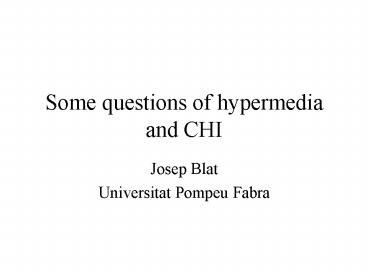Some questions of hypermedia and CHI - PowerPoint PPT Presentation
1 / 13
Title:
Some questions of hypermedia and CHI
Description:
GOMS tries to predict performance (and usability problems) when using computer systems ... in Human-Computer Interaction (Toward the Year 2000), Morgan Kauffman, 1995. ... – PowerPoint PPT presentation
Number of Views:41
Avg rating:3.0/5.0
Title: Some questions of hypermedia and CHI
1
Some questions of hypermedia and CHI
- Josep Blat
- Universitat Pompeu Fabra
2
Some aspects of human-computer interaction and
hypermedia
- General question Human information processing
based models (GOMS, for example) - Experimental evaluation is a must
- Complexity of developing successful hypermedia
3
GOMS, Human Information Processing
- GOMS (Card, Moran, Newell) stands for Goals,
Operators, Methods, Selection rules - GOMS tries to predict performance (and usability
problems) when using computer systems - Based on an Applied Psychology model of the Human
Information Processor - The HIP is composed of perceptual, motor and
cognitive systems (and corresponding perceptual
and cognitive memories, which can be short term
or long term)
4
Example of GOMS application
- The keystroke level model based on GOMS tries to
predict performance when using a text editing
system - Methods for this model are keystroking, pointing
with a mouse, returning the hands to home,
drawing a specific line, mental preparation,
response by system - Operators in this model are sequences of methods
allowing to perform a small unit-task
5
Example of GOMS application 2
- Parameters can be estimated and performance
predicted using some laws - For instance, Fitts law for time T required to
point with the mouse depends on size S of the
object, of distance D as T 1.03 .096 log
(D/S.5) it is based on the model of HIP - Constants were experimentally obtained
- Experimental validation of predictions can be
carried out
6
More general GOMS analysis
- Hierarchical decomposition and analysis of tasks
can be performed, in general, using GOMS at
different levels of granularity - We can compare different interfaces when
performing specific tasks (or alternative methods
which can be selected when using an interface) - There are other models refining this one, and
taking into account semantic, and syntactic
aspects allowing for analysis of interfaces
7
Concluding about GOMS
- Use Applied Psychology models of human
information processing - Develop task analysis, and performance models
- Predict and evaluate (time) performance
- GOMS is a relevant model
8
Experimental evaluation
- Under GOMS, experiments can be used to evaluate
prediction (and hence, predict performance) - General experimental evaluation is a must for a
user-oriented approach - Example Evaluating experimentally whether
hypertext browsing is better than using standard
(paper based) documentation
9
Evaluating hypertext vs traditional documentation
- Ask specific items for evaluation such as
- Searching fixed questions
- Writing essays
- Recalling incidental information
- Also ask about subjective rating
10
Evaluating hypertext vs traditional documentation
2
- Experimental results (1989) using Superbook
showed superiority - In accuracy when searching three out of four
fixed questions, especially when questions not
clearly in documentation headings, - When writing open book essays by students
- Recalling some incidental information
- Subjective rating gave also advantage to
Superbook - Seemingly, hypertext allows for better
performance in non-standard cases
11
Concluding about experimental evaluation of
hypertext
- Experimental evaluation is a must for
user-centred approach - Evaluation must be done with precise questions
- But also subjective rating is interesting
- Understand hypertext advantages with respect to
text
12
Seven barriers to successful hypermedia
development
- Glushko (1992) quotes seven pitfalls
- Realistic expectations
- Multidisciplinary project team
- Establishing and following design guidelines
- Dealing with installed base constraints
- Obtaining usable source files
- Finding appropriate software technologies and
methods - Legal uncertainties wrt intellectual property
concerns - Good commercial hypertext is hard to develop
13
Some references
- Ronald M Baecker et al Readings in
Human-Computer Interaction (Toward the Year
2000), Morgan Kauffman, 1995. Chapters 9 and 13. - Stuart K. Card, Thomas P. Moran, Allen Newell
The Psychology of Human-Computer Interaction,
Lawrence Erlbaum Associates, 1983.































